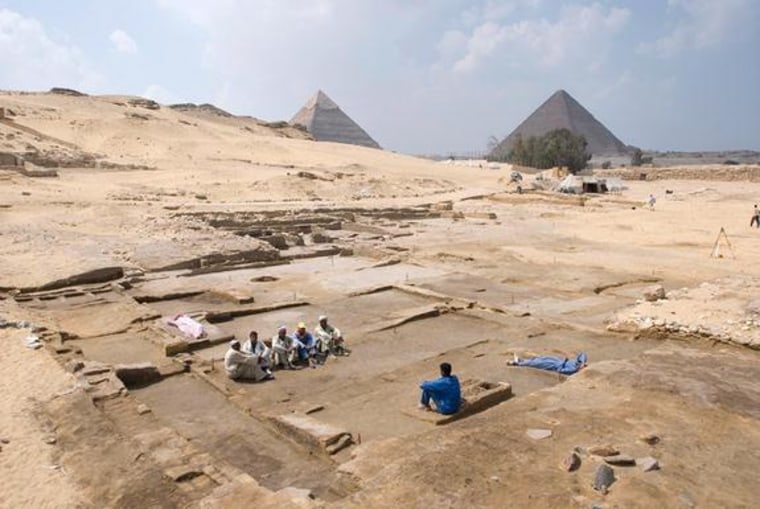TORONTO — The remains of a mansion that likely held high-ranking officials some 4,500 years ago have been discovered near Egypt's Giza Pyramids. Bones from young cattle and teeth from leopards suggest its residents ate and dressed like royalty.
Archaeologists excavating a city just 400 meters (1,312 feet) south of the Sphinx uncovered the house and nearby mound containing the hind limbs of young cattle, the seals of high-ranking officials, which were inscribed with titles like "the scribe of the royal box" and "the scribe of the royal school," and leopard teeth (but no leopard).
The house, containing at least 21 rooms, is part of a city that dates mainly to the time when the pyramid of Menkaure (the last of the Giza Pyramids) was being built. [See Photos of the Discoveries at Giza Pyramids]
"The other thing that is just amazing is almost all the cattle are under 10 months of age … they are eating veal," said Richard Redding, the chief research officer of Ancient Egypt Research Associates, at a recent symposium held here by the Society for the Study of Egyptian Antiquities.
"We have very, very, high status individuals," said Redding, also a research scientist at the Kelsey Museum of Archaeology at the University of Michigan.
Leopard teethBesides cattle bones the archaeologists found two leopard teeth in the house and another two in the nearby mound. They, however, found no leopard bones, leaving them with a puzzle.
Redding consulted ancient drawings that date to the Old Kingdom (the age when pyramid building was at its height), between 2649 and 2150 B.C. He found that some high-ranking individuals, including members of the royal family, wore leopard skin that still had the head attached. This would explain why they found teeth — which could've fallen out of the head while the wearer was passing by — but no leopard bones.
High-ranking clergy known as "sem" priests were allowed to wear these leopard skins, and they could be members of the royal house, noted Mark Lehner, the director of Ancient Egypt Research Associates, in an email to LiveScience.
Redding was also puzzled that many cattle hind bones, yet few forelimbs, were found. For some reason the people of the house avoided eating the forelimbs of the cattle. Again Redding turned to ancient drawings. There, he found numerous examples of scenes where people presented forelimbs as offerings to deities, but almost no examples of hind limbs being offered. As such, the people of this house were likely eating the remains of offerings.
Clues to a priestly complexThis discovery may help the archaeologists identify offering places and dwellings of ancient priests. Since the elite house is full of hind limbs (the remains of offerings), Redding suspects that bone deposits that contain mainly forelimbs would be located in places where the offerings were being made. [Photos: The Lost City of the Pyramid Builders]
The complex dates to a bit after the Giza Pyramids were built and may have been constructed at the site of an earlier town where people involved in the building of the Pyramid of Khafre (the second largest pyramid at Giza) lived.
- Owen Jarus, LiveScience contributor
This is a condensed version of a report from LiveScience.com. Read the full story here.
Follow us @livescience, Facebook & Google+. Original article on LiveScience.
- In Photos: Beautiful Pyramids of Sudan
- Image Gallery: The Beautiful Sarcophagus of an Egypt Pharaoh
- In Photos: 'Alien' Skulls Reveal Odd, Ancient Tradition
Copyright 2014 LiveScience, a TechMediaNetwork company. All rights reserved. This material may not be published, broadcast, rewritten or redistributed.
